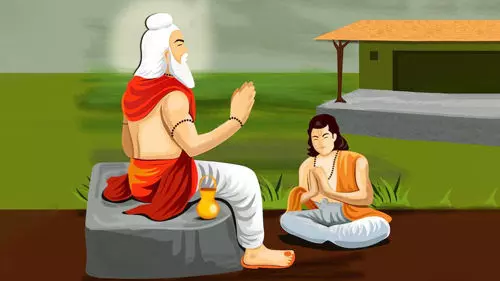The forgotten gurus: Reviving India’s ancient teaching traditions
In India, long before schools and degrees formalized learning, education followed a more intimate path, the guru–śiṣya parampara
By - Anoushka Caroline Williams |
Hyderabad: Every year on October 5, the world pauses to celebrate World Teachers’ Day, a tribute to those who shape minds and values across generations. Yet in India, long before schools and degrees formalized learning, education followed a more intimate path, the guru–śiṣya parampara, or the teacher-disciple tradition. It wasn’t just about instruction, but transmission, of skill, ethics, and worldview.
Once the backbone of India’s artistic, spiritual, and craft heritage, this centuries-old model is slowly fading under the weight of modern schooling and fast-paced careers. However, as education systems worldwide grapple with burnout, disconnection, and standardization, many experts believe this ancient model holds answers for the future.
Learning as a Living Relationship
In the guru–śiṣya system, learning was never transactional. It unfolded through long-term immersion and observation. Students lived with or near their teachers, internalizing not just lessons but values and conduct.
“Knowledge wasn’t delivered in modules, it was absorbed through coexistence,” explains Dr. Ramesh Iyer, education historian speaking to Newsmeter. “The teacher’s role was equal parts instructor, moral guide, and community anchor. It’s a relationship modern education is now trying to rebuild under new names like mentorship and coaching.”
This relationship-based approach allowed for tacit learning, the kind of nuanced knowledge that can’t be captured in manuals. A dancer’s grace, a potter’s rhythm, or a musician’s improvisation came alive only through observation and repetition.
Embedded Assessment Before Exams Existed
Unlike the exam-centric model of today, assessment in the parampara system was ongoing and practical. Students advanced as they demonstrated readiness, not because a calendar said so.
“Mastery was never rushed,” says Anita Sen, cultural anthropologist. “A guru would let a student perform or teach only when they were truly ready, it was a recognition of trust, not just completion.”
This patient, iterative approach also cultivated resilience and discipline, skills often missing in modern systems focused on speed and measurable output.
Where the Tradition Still Lives
The guru–śiṣya parampara continues in Indian classical music, dance, and certain craft traditions, though often in adapted forms. In Hindustani and Carnatic music, for instance, the idea of gharanas and banis keeps lineage and style intact.
Similarly, in weaving clusters like Kanchipuram and Kutch, apprentices still learn by shadowing master artisans. “We don’t teach with diagrams or theory. The loom itself teaches, but only if you sit beside someone who knows its language,” says S. Raghavan, a fourth-generation silk weaver.
Why It Matters Now
As India rethinks its education ecosystem through the National Education Policy (NEP) and new models of skill-based learning, traditional mentorship offers practical lessons.
“Apprenticeship-based education is not nostalgia, it’s neuroscience,” says Dr. Megha Paul, an education researcher at NIMHANS. “Repetition, observation, and emotional connection activate the deepest learning pathways. The ancient system intuitively understood that.”
The parampara also reinforces ethical learning, something formal institutions often overlook. “A true teacher in that system was responsible not only for what the student knew, but for who the student became,” adds Sen. “That moral formation is what makes the model timeless.”
Modern Roadblocks
Despite its depth, the guru–śiṣya system has declined due to urban migration, commercialization, and lack of institutional support. Many master teachers struggle with financial insecurity and dwindling disciples.
“The tradition suffered when we stopped valuing time,” says Usha Rao, a senior Bharatanatyam exponent. “Students now want certificates, not surrender. But surrender, the willingness to trust and absorb, was the foundation of learning.”
Additionally, unregulated environments sometimes created power imbalances. Experts stress that revival must come with transparency, ethics, and legal protection for both teachers and students.
Reimagining the Tradition for Today
Educators and policymakers are now exploring hybrid models that combine traditional mentorship with modern safeguards and accessibility.
• Music conservatories now integrate long-term guru residencies with academic programs.
• Craft schools offer paid apprenticeships under recognized artisans, combining practical learning with financial stability.
• Yoga and classical arts institutions are establishing ethical codes and multi-mentor systems to ensure accountability.
“Revival doesn’t mean going backward,” says Sen. “It means preserving the emotional and ethical core of the parampara while modernizing its structure.”
The Future of the Ancient Classroom
In an age where education is increasingly digitized, the guru–śiṣya parampara reminds us that knowledge transfer is as much emotional as it is intellectual. A YouTube tutorial can teach a scale; only a teacher can teach sensitivity, patience, and purpose.
As World Teachers’ Day celebrates educators who shape society, India’s forgotten gurus offer a powerful reminder: the greatest lessons were once learned not in classrooms but in companionship.
Quick Takeaway
• India’s guru–śiṣya parampara was a living, relationship-based model of learning.
• It emphasized ethics, repetition, and embodied practice over exams.
• Fields like classical arts and crafts still preserve its essence.
• Experts urge for hybrid revival models combining mentorship and modern safeguards.
• The system’s greatest lesson: teaching is not just about information, but transformation.